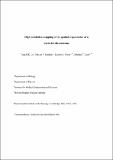| dc.contributor.author | Imakaev, Maksim Viktorovich | |
| dc.contributor.author | Le, Tung | |
| dc.contributor.author | Mirny, Leonid A | |
| dc.contributor.author | Laub, Michael T | |
| dc.date.accessioned | 2014-04-07T15:00:12Z | |
| dc.date.available | 2014-04-07T15:00:12Z | |
| dc.date.issued | 2013-10 | |
| dc.date.submitted | 2013-06 | |
| dc.identifier.issn | 0036-8075 | |
| dc.identifier.issn | 1095-9203 | |
| dc.identifier.uri | http://hdl.handle.net/1721.1/86053 | |
| dc.description.abstract | Chromosomes must be highly compacted and organized within cells, but how this is achieved in vivo remains poorly understood. We report the use of chromosome conformation capture coupled with deep sequencing (Hi-C) to map the structure of bacterial chromosomes. Analysis of Hi-C data and polymer modeling indicates that the Caulobacter crescentus chromosome consists of multiple, largely independent spatial domains that are probably composed of supercoiled plectonemes arrayed into a bottle brush–like fiber. These domains are stable throughout the cell cycle and are reestablished concomitantly with DNA replication. We provide evidence that domain boundaries are established by highly expressed genes and the formation of plectoneme-free regions, whereas the histone-like protein HU and SMC (structural maintenance of chromosomes) promote short-range compaction and the colinearity of chromosomal arms, respectively. Collectively, our results reveal general principles for the organization and structure of chromosomes in vivo. | en_US |
| dc.description.sponsorship | National Institutes of Health (U.S.) (Grant R01GM082899) | en_US |
| dc.description.sponsorship | National Institutes of Health (U.S.) (Grant U54CA143874) | en_US |
| dc.language.iso | en_US | |
| dc.publisher | American Association for the Advancement of Science (AAAS) | en_US |
| dc.relation.isversionof | http://dx.doi.org/10.1126/science.1242059 | en_US |
| dc.rights | Article is made available in accordance with the publisher's policy and may be subject to US copyright law. Please refer to the publisher's site for terms of use. | en_US |
| dc.source | Laub via Courtney Crummett | en_US |
| dc.title | High-Resolution Mapping of the Spatial Organization of a Bacterial Chromosome | en_US |
| dc.type | Article | en_US |
| dc.identifier.citation | Le, T. B. K., M. V. Imakaev, L. A. Mirny, and M. T. Laub. “High-Resolution Mapping of the Spatial Organization of a Bacterial Chromosome.” Science 342, no. 6159 (November 8, 2013): 731–734. | en_US |
| dc.contributor.department | Massachusetts Institute of Technology. Institute for Medical Engineering & Science | en_US |
| dc.contributor.department | Massachusetts Institute of Technology. Department of Biology | en_US |
| dc.contributor.department | Massachusetts Institute of Technology. Department of Physics | en_US |
| dc.contributor.department | Massachusetts Institute of Technology. School of Engineering | en_US |
| dc.contributor.approver | Laub, Michael T. | en_US |
| dc.contributor.mitauthor | Le, Tung Ba Khanh | en_US |
| dc.contributor.mitauthor | Imakaev, Maksim Viktorovich | en_US |
| dc.contributor.mitauthor | Mirny, Leonid A. | en_US |
| dc.contributor.mitauthor | Laub, Michael T. | en_US |
| dc.relation.journal | Science | en_US |
| dc.eprint.version | Author's final manuscript | en_US |
| dc.type.uri | http://purl.org/eprint/type/JournalArticle | en_US |
| eprint.status | http://purl.org/eprint/status/PeerReviewed | en_US |
| dspace.orderedauthors | Le, T. B. K.; Imakaev, M. V.; Mirny, L. A.; Laub, M. T. | en_US |
| dc.identifier.orcid | https://orcid.org/0000-0003-4764-8851 | |
| dc.identifier.orcid | https://orcid.org/0000-0002-0785-5410 | |
| dc.identifier.orcid | https://orcid.org/0000-0002-8288-7607 | |
| dc.identifier.orcid | https://orcid.org/0000-0002-5320-2728 | |
| mit.license | PUBLISHER_POLICY | en_US |
| mit.metadata.status | Complete | |
